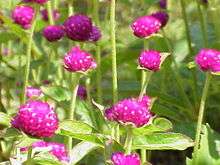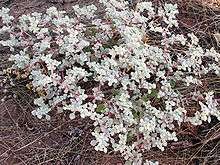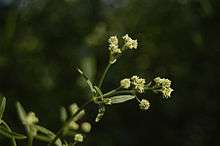Gomphrenoideae
The Gomphrenoideae are a subfamily of the Amaranthaceae.
| Gomphrenoideae | |
|---|---|
 | |
| Gomphrena globosa | |
| Scientific classification | |
| Kingdom: | Plantae |
| Clade: | Tracheophytes |
| Clade: | Angiosperms |
| Clade: | Eudicots |
| Order: | Caryophyllales |
| Family: | Amaranthaceae |
| Subfamily: | Gomphrenoideae Schinz |
| Genera | |
|
about 13 genera, see text | |
The stamens have anthers with only one lobe (locule) and two pollen sacs. Many species show C4-photosynthesis pathway.[1]
The center of diversity lies in Central America, Mexico and the dry forests and thorn bush savannas of South America.[2]
Systematics
The subfamily Gomphrenoideae was first published in 1893 by Hans Schinz (in: Engler und Prantl (Eds.): Die Natürlichen Pflanzenfamilien vol. 3, 1a, p. 97).
According to phylogenetic research by Sanchez Del-Pino (2009), the subfamily Gomphrenoideae Schinz is regarded as a monophyletic taxon with 19 genera and about 300-400 species. The traditional classification with two tribes (Gomphreneae and Pseudoplantageae) does not reflect the phylogenetic relationship in this group. Three clades can be recognized.:[1]
Iresinoids
- Irenella Suess., with only one species:
- Irenella chrysotricha Suess., in rain forests of Ecuador. Phylogenetically, it falls within Iresine.
- Iresine P.Browne (Syn.: Dicraurus Hook. f.): with about 45 species in North and South America.
- Woehleria Griseb.: with only one species
- Woehleria serpyllifolia Griseb., on mountain coasts of Cuba. Phylogenetically, it falls within Iresine.
This is the sister clade of the two other clades.
Alternantheroids
- Alternanthera Forssk. (Syn.: Brandesia Mart.): with about 100-200 species, mainly in America, also in Africa and Australia.
- Pedersenia Holub: with about 10 species in tropical America.
- Tidestromia Standl.: with about 6 species in deserts of southern North America.
C4 carbon fixation evolved independently in the genera Alternathera, which also contains C3 and C3–C4 intermediate species, and Tidestromia.[3][4]
Gomphrenoids
- Blutaparon Raf. (Syn.: Philoxerus R.Br.): with about 5 species at shores of North and Middle America, West Africa, Micronesia and Japan, for example:
- Froelichia Moench: with about 12 species in America.
- Froelichiella R.E.Fr., with only one species:
- Froelichiella grisea R.E.Fr. in Brasília.
- Gomphrena L. (Syn.: Bragantia Vand.): with about 90 species in America and about 30 species in Australia. This genus is polyphyletic, so taxonomical changes have to be expected.[1]
- Gomphrena pulchella
- Gomphrena decumbens
- Gomphrena globosa
- Gossypianthus Hook.: with 2 species in southern North America.
- Guilleminea Kunth (Syn.: Brayulinea Small)
- Hebanthe Mart.: with about 7 species in tropical America.
- Hebanthodes Pedersen, with only one species:
- Hebanthodes peruviana Pedersen in Peru.
- Lithophila Sw., with 2 species on Galapagos and the Caribic
- Pfaffia Mart.: with about 35 species in tropical America.
- Pseudogomphrena R.E.Fr.,with only one species:
- Pseudogomphrena scandens R.E.Fr. in Brasília.
- Pseudoplantago Suess.: with one species in Venezuela and one in Argentina.
- Quaternella Pedersen: with 3 species in Brasília.
- Xerosiphon Turcz.: with about 2 species in Brasília.
One large clade within this group, containing the genera Froelichia, Guilleminea, Blutaparon, some Gomphrena species, and probably Gossypianthus and Lithophila, has acquired the C4 carbon fixation pathway.[3][4] Some of these C4 species occur at unusually high altitudes in the Andes, in cooler conditions than their C3 relatives.[5]
Photographs
 Iresinoids:
Iresinoids:
Iresine lindenii_in_Hyderabad%2C_AP_W_IMG_8030.jpg) Alternantheroids: Alternanthera caracasana
Alternantheroids: Alternanthera caracasana Alternantheroids:
Alternantheroids:
Tidestromia lanuginosa Gomphrenoids: Gomphrena serrata
Gomphrenoids: Gomphrena serrata Gomphrenoids:
Gomphrenoids:
Pfaffia glomerata
References
- Ivonne Sánchez del-Pino, Thomas Borsch & Timothy J. Motley (2009): trnL-F and rpl16 Sequence Data and Dense Taxon Sampling Reveal Monophyly of Unilocular Anthered Gomphrenoideae (Amaranthaceae) and an Improved Picture of Their Internal Relationships, In: Systematic Botany, Volume 34 (1), p. 57-67. doi:10.1600/036364409787602401
- Kai Müller & Thomas Borsch (2005): Phylogenetics of Amaranthaceae using matK/trnK sequence data – evidence from parsimony, likelihood and Bayesian approaches, In: Annals of the Missouri Botanical Garden, 92, p. 66-102.
- Sage, R.F. (2016). "A portrait of the C4 photosynthetic family on the 50th anniversary of its discovery: species number, evolutionary lineages, and Hall of Fame". Journal of Experimental Botany. 67 (14): 4039–4056. doi:10.1093/jxb/erw156. ISSN 0022-0957. PMID 27053721.

- Sage, R.F.; Sage, T.L.; Pearcy, R.W.; Borsch, T. (2007). "The taxonomic distribution of C4 photosynthesis in Amaranthaceae sensu stricto". American Journal of Botany. 94 (12): 1992–2003. doi:10.3732/ajb.94.12.1992. ISSN 0002-9122. PMID 21636394.

- Bena, M.J.; Acosta, J.M.; Aagesen, Lone (2017). "Macroclimatic niche limits and the evolution of C4 photosynthesis in Gomphrenoideae (Amaranthaceae)". Botanical Journal of the Linnean Society. 184 (3): 283–297. doi:10.1093/botlinnean/box031. ISSN 0024-4074.
| Wikimedia Commons has media related to Gomphrenoideae. |
| Wikispecies has information related to Gomphrenoideae |